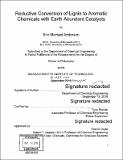Reductive conversion of lignin to aromatic chemicals with earth abundant catalysts
Author(s)
Anderson, Eric Michael,Ph. D.Massachusetts Institute of Technology.
Download1149013461-MIT.pdf (29.39Mb)
Other Contributors
Massachusetts Institute of Technology. Department of Chemical Engineering.
Advisor
Yuriy Román.
Terms of use
Metadata
Show full item recordAbstract
The viability of lignocellulosic biomass as a feedstock for chemicals hinges on the successful utilization of the lignin. Lignin, which comprises 15-30 wt% of biomass, is an amorphous polymer composed of multiple phenolic monomers. Lignin polymerization occurs through an uncontrolled radical coupling of monomers leading to an array of C-O and C-C bonds in the polymer. As such, lignin is highly recalcitrant and is responsible for the poor utilization of biomass. Many harsh thermochemical processes exist to extract lignin, but typically result in the destruction and condensation of the lignin rendering it as process waste. Alternative fractionation techniques focused on preserving lignin have recently been developed. These methods utilize reduction catalysts to depolymerize and stabilize reactive lignin fragments to produce stable phenols. This work focuses on the design of flow reactors to understand this process, evaluate catalysts and elucidate how structural changes in biomass impact lignin depolymerization and upgrading. Our lignin conversion process operates by adding a heterogeneous reduction catalyst with whole biomass, a solvent and a reducing agent. Two key steps were discovered in the reductive conversion of lignin. First, lignin oligomers are liberated from the biomass by solvolytic cleavage of lignin-carbohydrate bonds. Next, lignin oligomers are reductively fragmented at the catalyst surface to produce stable phenolic compounds. Lignin solvolysis and reduction were physically separated in a dual-bed flow-through reactor, which allows for independent control of each step. Direct control of lignin solvolysis and reduction allowed for limiting conditions to be isolated. Reduction limited conditions were used to study catalyst activity and stability. Solvolysis limiting conditions were used to probe how lignin structure influences product selectivity and yield. Additionally, molybdenum-based catalysts were developed for the conversion of lignin-derived phenols into aromatics. Gas phase reactions with n-propyl guaiacol demonstrated that molybdenum polyoxometalates are effective catalysts to perform simultaneous alkylationƯhydrodeoxygenation to produce alkylated aromatics from phenolics. Finally, the dual-bed reactor was used to combine reductive fractionation and deoxygenation chemistry to directly convert lignin into aromatics over a molybdenum carbide catalyst. Overall, a versatile reactor system was developed to facilitate fundamental studies to understand biomass structure and catalyst performance.
Description
Thesis: Ph. D., Massachusetts Institute of Technology, Department of Chemical Engineering, 2019 Cataloged from PDF version of thesis. "The pagination in this thesis reflects how it was delivered to the Institute Archives and Special Collections. The Table of Contents does not accurately represent the page numbering"--Disclaimer Notice page. "February 2019." Includes bibliographical references (pages 209-228).
Date issued
2019Department
Massachusetts Institute of Technology. Department of Chemical EngineeringPublisher
Massachusetts Institute of Technology
Keywords
Chemical Engineering.